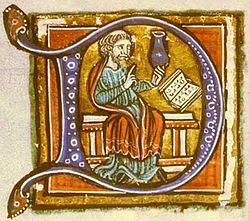Islamic Golden Age
The Islamic Golden Age, also sometimes known as the Islamic Renaissance,[1] is traditionally said to have lasted from the 8th century to the 13th century.[2] However, some place its start as early as the Umayyad Caliphate (founded in 661 by Caliph Mu'awiya I)[3][4] and its end as late as the late 15th and the 16th centuries, including the rise of the Islamic gunpowder empires: the Ottoman Empire, the Safavid Empire, and the Mughal Empire.[5]
The Islamic Golden Age is traditionally understood to have begun during the reign of Abbasid Caliph Harun al-Rashid (786 to 809) who started in the 8th century the House of Wisdom in Baghdad, the world's largest city. The library saw scholars from all over the Muslim world flock to translate the known world's classical knowledge into Arabic and Persian.[6] Under the Umayyads, Al-Andalus also became a centre of science, medicine, philosophy, and inventions during the Islamic Golden Age.[7][8]
The period got its name because engineers, scholars, and traders in the Islamic world did much for the arts, agriculture, economics, industry, law, literature, navigation, philosophy, sciences, and technology. They built upon earlier traditions and added inventions and innovations of their own.[9] Howard R. Turner wrote, "Muslim artists and scientists, princes and laborers together created a unique culture that has directly and indirectly influenced societies on every continent."[9]
Islamic Golden Age Media
Improvements to the astrolabe were one of the achievements of this era
Expansion of the Caliphates, 622–750:* Expansion under Muhammad, 622–632* Expansion during the Rashidun Caliphate, 632–661* Expansion during the Umayyad Caliphate, 661–750
The Christian physician Hunayn ibn Ishaq led the translation of works.
A manuscript written on paper during the Abbasid Era
Organized instruction in the Cairo Al-Azhar Mosque began in 978
An Arabic manuscript from the 13th century depicting Socrates (Soqrāt) in discussion with his pupils
Geometric patterns: an archway in the Sultan's lodge in the Ottoman Green Mosque in Bursa, Turkey (1424), its girih strapwork forming 10-point stars and pentagons
Other websites
- Golden age of Arab and Islamic Culture Archived 2007-12-22 at the Wayback Machine
- The Influence of Islamic Philosophy and Ethics on The Development of Medicine During the Islamic Renaissance - By Dr. Sharif Kaf Al-Ghazal
Notes
| Wikimedia Commons has media related to Lua error in Module:Commons_link at line 62: attempt to index field 'wikibase' (a nil value).. |
- ↑ Joel L. Kraemer (1992), Humanism in the Renaissance of Islam, p. 1 & 148, Brill Publishers, ISBN 9004072594.
- ↑ Matthew E. Falagas, Effie A. Zarkadoulia, George Samonis (2006). "Arab science in the golden age (750–1258 C.E.) and today", The FASEB Journal 20, p. 1581-1586.
- ↑ Rodríguez, Manuel Lozano (19 June 2023). Bioethics of Displacement and Its Implications. IGI Global. ISBN 9781668448090.
- ↑ Haberl, Ferdinand J. (22 March 2023). Jihadi Intelligence and Counterintelligence: Ideological Foundations and Operational Methods. Springer. ISBN 9783031247446.
- ↑ Starr, S. Frederick (2013-10-06). Lost Enlightenment: Central Asia's Golden Age from the Arab Conquest to Tamerlane. Princeton University Press. ISBN 978-1-4008-4880-5.
- ↑ Gutas, Dimitri (1998). Greek Thought, Arabic Culture: The Graeco-Arabic Translation Movement in Baghdad and Early 'Abbāsid Society (2nd-4th/8th-10th Centuries). London: Routledge.[page needed]
- ↑ Simon Barton (30 June 2009). A History of Spain. Macmillan International Higher Education. pp. 44–5. ISBN 978-1-137-01347-7.[dead link]
- ↑ Francis Preston Venable (1894). A Short History of Chemistry. Heath. p. 21.
- ↑ 9.0 9.1 Howard R. Turner, Science in Medieval Islam, University of Texas Press, November 1, 1997, ISBN 0-292-78149-0, pg. 270 (book cover, last page)









